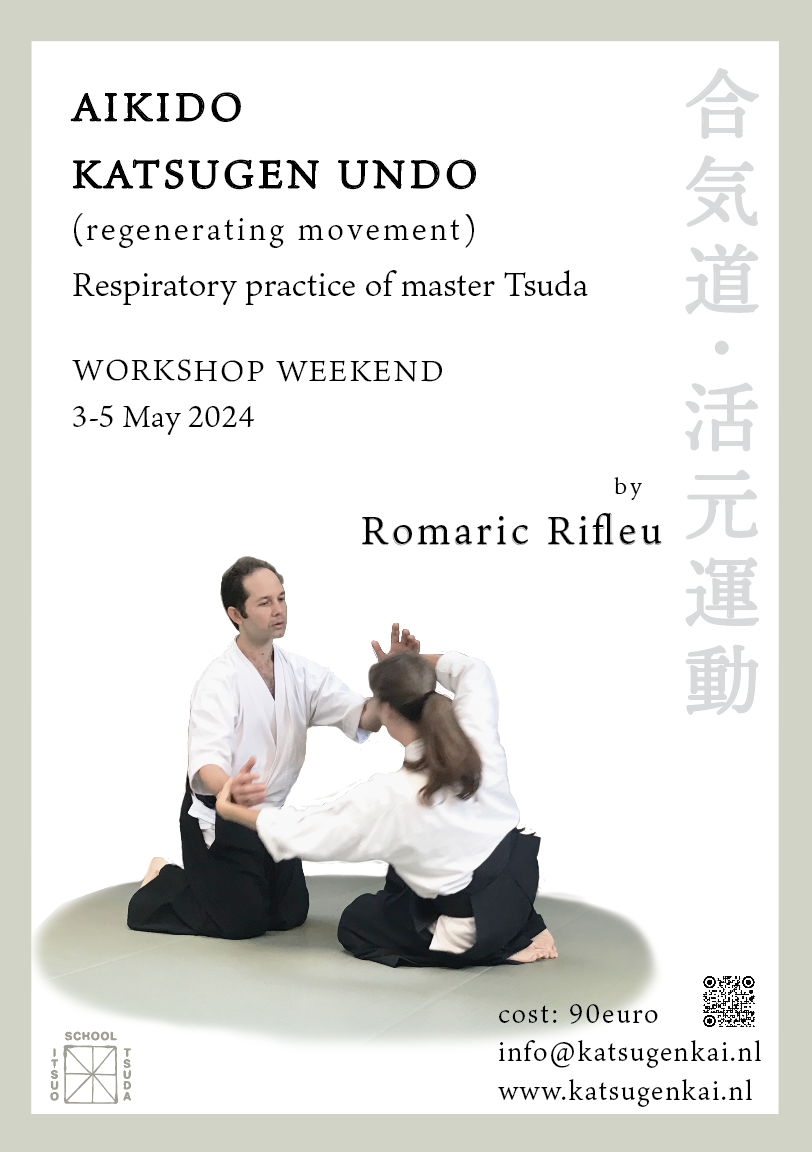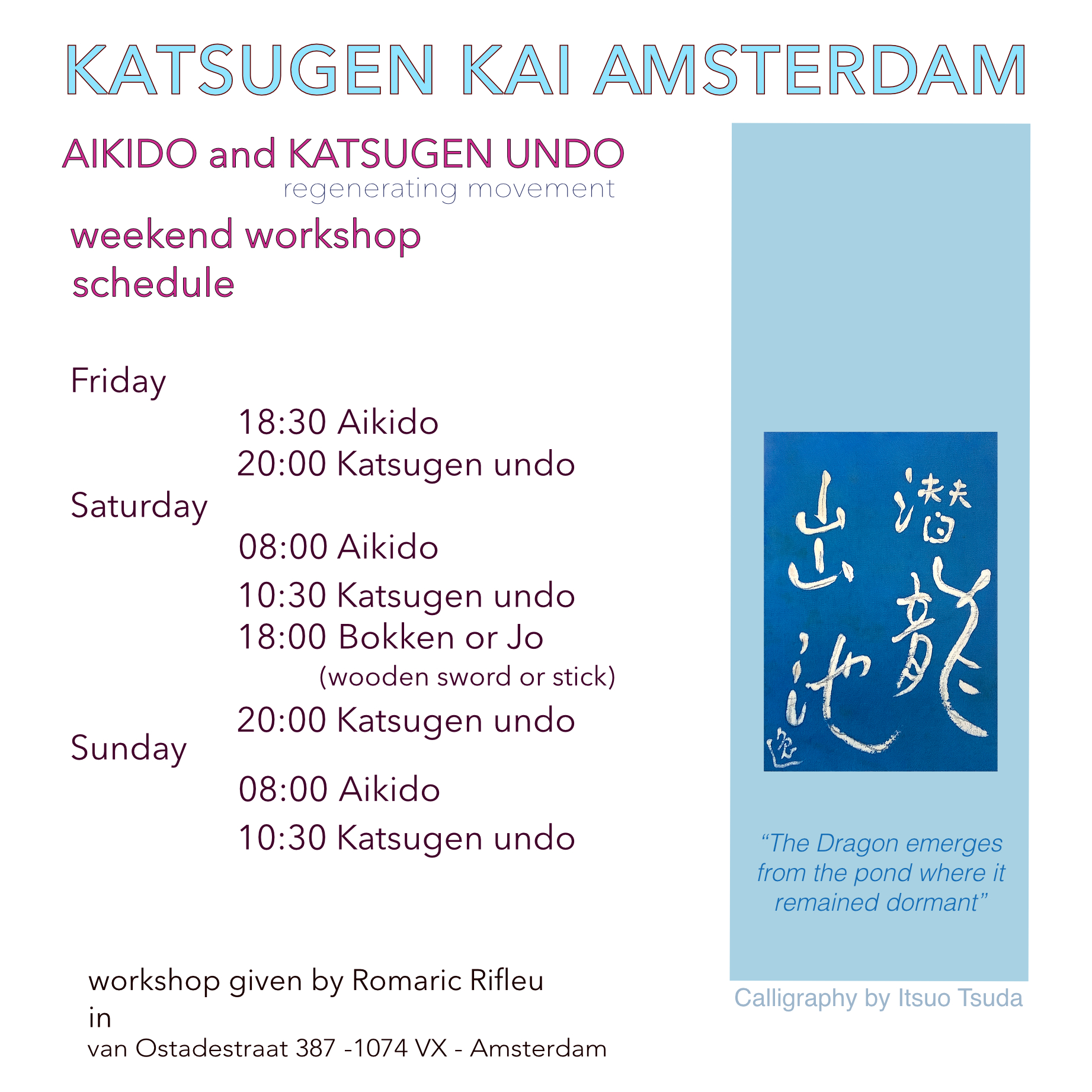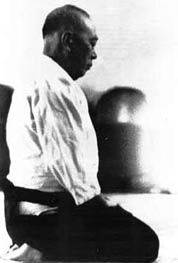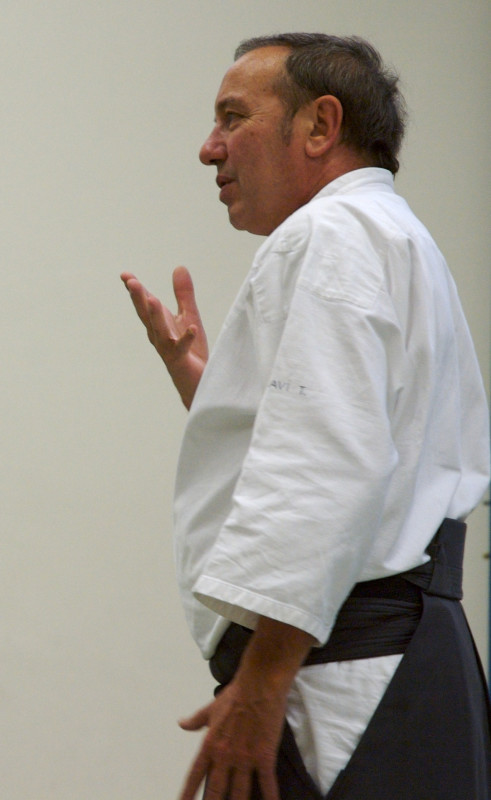ASSOCIATION KATSUGEN KAI AMSTERDAM
Respiratory practice ~ Aikido //
Katsugen Undo

|
| |
Workshops Aikido / Katsugen Undo in Amsterdam by Romaric Rifleu
Calendar 2023/2024
|
|
29, 30 SEPTEMBER - 1 OCTOBER 2023
|
|
2 - 4 FEBRUARY 2024
|
|
3 - 5 MAY 2024
|
For more information please click here
|
|

|

Katsugen Kai
Calligraphy by Itsuo Tsuda Sensei |
| Monday |
18:30h
20:30h |
Respiratory practice
~ Aikido
Katsugen Undo |
| Wednesday |
07:15h
|
Respiratory practice ~
Aikido
|
| Friday |
18:30h
20:30h |
Respiratory practice ~
Aikido
Katsugen Undo
|
| Sunday |
08:00h
10:00h |
Respiratory practice ~
Aikido
Katsugen Undo
|
Monthly contribution
Aikido: €35,00
Katsugen Undo: €25,00
Regular
Katsugen Undo practice is only possible after attending a workshop in one
of the dojos of the Itsuo Tsuda School.
Aikido + Katsugen Undo: €50,00 (bundle
discount)
___________________________________________________
First Aikido session is free.
First Aikido month is discounted ~ discovery fee €25,00
|
Okido Yoga Dojo
van Ostadestraat 387, 1074 VX Amsterdam [map]
INFO
email: info@katsugenkai.nl [click here]
|
|
Workshops Aikido and K.U. by Régis Soavi Sensei
Calendar 2023/2024
|
|
Parijs
"Tenshin"
22 - 24 September 2023
15 - 17 December 2023
1 - 3 March 2024
17 - 19 May 2024 |
Milaan
"Scuola della Respirazione"
1 - 3 December 2023
2 - 4 February 2024
12 - 14 April 2024 |
Toulouse
"Yuki Hō"
10 - 12 November 2023
12 - 14 January 2024
22 - 24 March 2024
7 - 9 June 2024 |
|
Rome
"Bodai"
16 - 18 February 2024
|
- Summer seminar -
(Mas d'Azil)
14 - 27 July 2024
|
|
For more information please contact the dojos.
|
|

|
Itsuo Tsuda was born
in 1914. At 16, he rebelled against his father's wish that he take up
the family business (being the older son); he left his family in search
of freedom of thought. Later, reconciled with his father, he came to
France in 1934 and studied under Marcel Granet and Marcel Mauss until
1940, when he returned to Japan . After 1950, he became interested in
Japanese culture, studying the recitation of "Noh" with Master Hosada,
the "Seitai" with Master Noguchi, and Aikido with Master Ueshiba. Itsuo
Tsuda came back to Europe in 1970 to disseminate the practice of
"Regenerating Movement" and his ideas about the "Ki".
He died in 1984.
|
 |
Régis
Soavi Sensei begins to practice a traditional and supple
type of judo around the age of twelve. In the 1970s, he starts training
in aïkido with Nocquet, Tamura and Noro, later becoming an instructor
in the schools of those three Masters. In the same period he also
teaches within the French Aïkikaï Federation. In 1973 he encounters
Master Itsuo Tsuda in Paris and begins to follow his teaching,
practising with him Aïkido and Katsugen Undo ( the Regenerating
Movement) for ten years, until Master Tsuda’s death. Parallel to that,
Tatsuzawa Sensei introduces him to the arts of his school, the Bushûden
Kiraku-ryu: Iaïdo (the sword), Kenjutsu and Jujitsu. During the same
decade, still taking part in a number of seminars and courses, he has
the opportunity of meeting several Masters among whom Kisshomaru
Ueshiba, Yamaguchi, Kobayashi as well as Shirata for example.
About 1980, he turns away for good from this official vision of Aïkido,
as Master Tsuda’s teaching is much more deeply in accordance with the
path he wants to follow: the practice of the “Non-Doing” through Aïkido
and Katsugen Undo. As a matter of fact, one of the distinctive elements
of this teaching is the link established by Itsuo Tsuda himself between
the understanding of Aïkido he developed throughout the years he spent
with the founder Ô Sensei Ueshiba on the one hand, and the practice of
Katsugen Undo he had already discovered with Master Noguchi, the founder
of Seitai, on the other hand. With Master Tsuda these two practices
become so to speak complementary.
In 1982, having met his Master’s approval to do so, Régis Soavi decides
to dedicate himself, as a professional, solely to Aïkido and Katsugen
Undo ( he had already been teaching Aïkido since 1975). In the following
years, he founds his first dojo in Toulouse, in the south of France,
and starts holding seminars in Paris, Toulouse and Milano.
At present, he teaches at the dojo Tenshin and still conducts seminars
regularly at the dojos in Milano, Paris and Toulouse, and more
occasionally in Rome, Amsterdam and Jerusalem.
|
Respiratory practice
of Master Tsuda
Kokyu Nage
"The word Kokyu may be
translated into English by respiration, since Ko is equivalent to
breathing out, and Kyu to breathing in. It's the union of these two
phenomena which engenders respiration. But for Tsuda Sensei, the word
"Kokyu" has an unsuspected scope extending far beyond the biochemical or
gymnastic conception of respiration. He often said that, through
respiration, "Aïkido is an art of becoming children again... without
being childish”.
How
should one understand this statement from a technical point of view?
It's simple. When someone stronger than yourself seizes you round the
waist from behind so that you cannot sit down, what should you do? Throw
the person forward so that you're free to sit down? As he is heavier
than you are, you cannot do that. What then? Tsuda Sensei answers : "
become a child ". I see a wonderful shell lying on the beach and I bend
forward to pick it up. I forget about whoever is still holding me tight
from behind. The ki flows out from myself towards the shell, whereas
before, it was blocked at the thought of the opponent who is holding me
so strongly. He then becomes light and tumbles over my shoulders...
The idea of throwing
someone forward induces resistance. In the action of the child, there is
the joy of picking up the shell, and that's what makes one forget the
presence of the opponent.
To forget the
opponent, although still aware that he is there : that isn't a very easy
thing to do. The more one tries to forget, the more one thinks about
it. It's the joyful flow of ki which makes one forget everything...
The practise of
Aïkido implies, therefore, that you adopt the principle of
non-resistance, in the sense that one neither pushes nor pulls the
opponent ; one avoids acting in a way likely to arouse an antagonistic
force. Another implication is the principle of the non-opponent. For as
soon as we think about the opponent, our ki is absorbed by him, our
respiration/attention is blocked. But in order not to be absorbed by the
opponent, one must have a certain power of respiration.
Master Ueshiba often
said :
" Aïkido is an art
whereby people unite and become separate again ( musunde hanatsu
) ".
I have found this alternance between union and separation, in
the act of inhaling and exhaling.
First comes the
defender's inhalation ( I use the word defender for the time being,
though there are no such terms as defender or attacker in Aïkido ),
which initiates the action. I raise my hand as I inhale, and the
attacker immediately follows my movement, raising his own hand. There is
a synchronization of the intake of breath of both partners, at the same
time as a coordination of movements. This reciprocal interaction is, I
believe, one of the distinctive features of Aïkido. One doesn't find it
in Judo or in Kendo, where each person breathes independently from the
other and watches for an opportunity to attack the other.
At first, this
interaction isn't at all obvious. One only performs a certain number of
movements one has learned. After some time, I realized that there is a
coordination of movements in Aïkido. That means, if I raise my bokken,
the attacker raises his at the same moment. In Kendo, one doesn't have
to keep to this conventional form of training. If one person raises the
shinai, the other may counter by swiping horizontally the abdomen.
Why do both partners
make identical or symetrical movements in Aïkido? After all, one can't
really ask one's opponent : " would you be so kind as to raise your hand
at the same time as I raise mine, please? " For such a thing to be
possible, there must be a compelling force which makes the partner act
as one wishes. I have found this force in the intake of breath, prior
even to the action itself. Once the fusion has taken place and the act
is in progress, breathing out follows naturally, which allows the flow
of ki. One then sees the throwing forward of the partner, etcetera, as a
visible form of the technique.
Respiration is, in my
experience, the very foundation of Aïkido.
extract from Bushido
Magazine
1984
|
Katsugen Undo
WHAT IS THE REGENERATING
MOVEMENT
The regenerating movement is
done through the momentary suspension of our voluntary system.
It requires no special knowledge or technique. On the contrary,
we must leave that aside. To seek a
pre-determined goal only hinders the natural evolution of our
nature.
The principle that we have
formulated is thus :
"WITHOUT KNOWLEDGE, WITHOUT
TECHNIQUE, WITHOUT AIM"
For the person who sees the
regenerating movement for the first time, the sight is rather
surprising. As we are accustomed to movements that are more or less
controlled, governed by the intellect or studied, any movement that
falls outside the domain of conscious control suggests to us illness,
madness, or hypnotism; the regenerating movement seems to lend itself to
such interpretations.
In reality, it is quite
different. During the practice of movement, our consciousness, instead
of being anxious like that of someone ill, remains calm and serene.
Instead of being confused, like that of a madman, it remains lucid.
Instead of being circumscribed and limited like that of someone under
hypnosis, it remains free.
One does not perform the
regenerating movement. It is set in motion spontaneously, in response to
the needs of the organism.
As those needs vary from one
individual to another and for the same individual, from one moment to
another, there can be no uniform, pre-programmed movement. Because of
this, there is nothing easier than to slip away from what is natural, by
adding a few "seductive ingredients".
Theoretically, there exist two
forms of regenerating movement: the first already present in every
individual consists of natural reactions of our organism such as:
yawning, sneezing, movements and agitation during sleep, etc. The second
was developed by Master Haruchika Noguchi, a half century ago. This is
the form we practice.
To be initiated to the practice
of the movement, it is preferable to have reached a certain degree of
mental maturity and that all other proposed solutions, be felt to be
inadequate. It must not be imposed on others, not even on your family,
and not just any time. It is essential that the desire germinate in the
inner self for a return to something natural. One mustn't pick fruit
before it is ripe.
The regenerating movement is
not an exterior acquisition. It points the way to a deeper discovery of
oneself. This way is not a straight road to paradise, but a twisting
path.
It is up to each of us with his
own responsibility, to discover our own oneness of being.
As the body becomes more
sensitive, one can experience some perturbing sensations, which can
repel those who lack a good initial understanding.
The movement, after reaching a
certain level of intensity, gradually becomes calmer. It becomes more
subtle. Our respiration becomes more profound. Finally the movement
fuses together with the movement of daily life, becoming so natural that
there is no need to do anything special for it no more. The terrain has
been normalized.
This normalization is not only
physical, but psychic as well. A new perspective is created as our
aptitude develops for that fusion of sensitivity which affects human
relationships and our reactions to life around us. If this fusion enlarges our open-mindedness, we reach the state
of non-body and non-mind.
We can then discover that man is fundamentally free..
Itsuo Tsuda
Simple as Breath
Meeting Régis Soavi's Aikido and
the “Respiratory Practice” of Master Tsuda.
Hello, Illness
An interview with Régis Soavi about
Katsugen Undo (or Regenerating Movement)
These articles were issued in the Italian magazine Arti
d'Oriente in February 1999 and May 2000.
They are transcription of two interview of Régis Soavi made
in Milano by Monica Rossi, a journalist in the magazine.
______________________________________
|
| |
|


